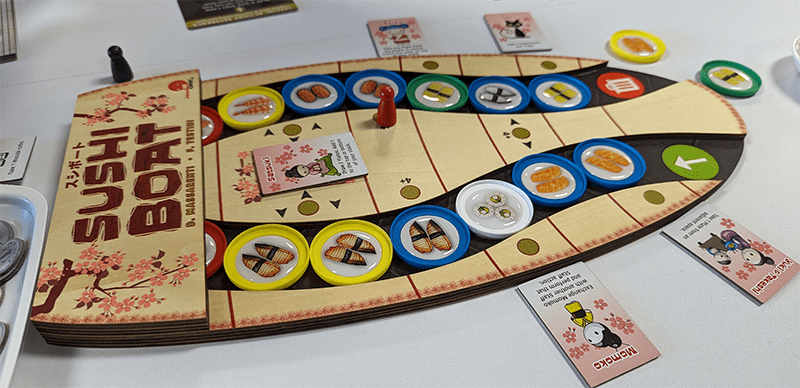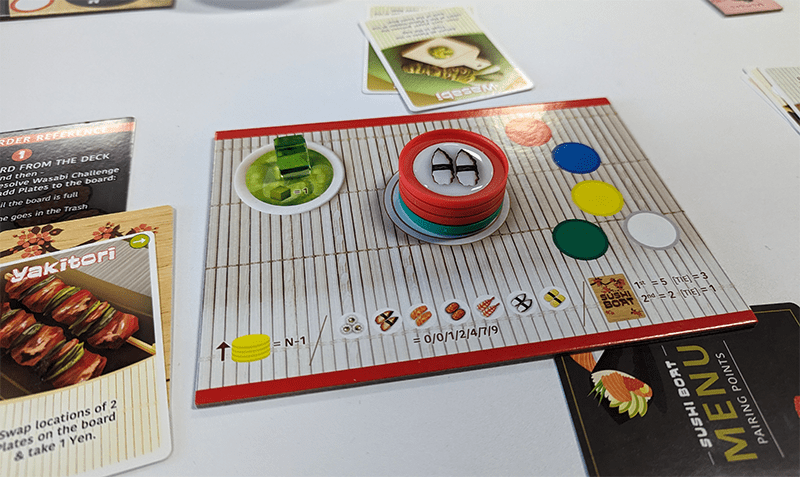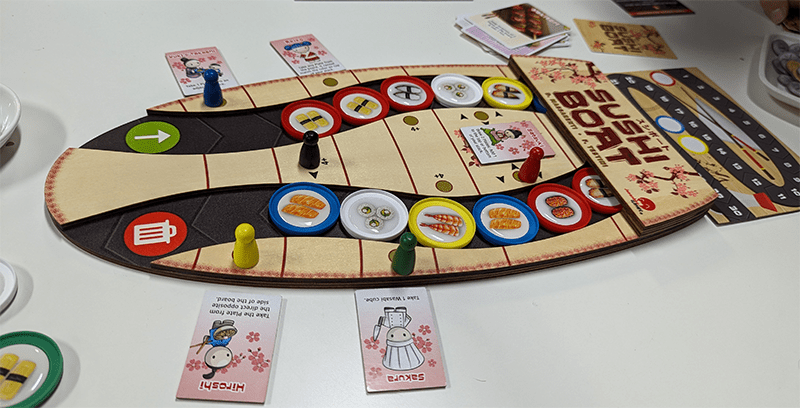Disclosure: Meeple Mountain received a free copy of this product in exchange for an honest, unbiased review. This review is not intended to be an endorsement.
Sushi. Drafting. Set Collection. I’m a simple man, and it doesn’t take much to get my attention.
Attention doesn’t immediately mean praise or endorsement, but it does mean I am going to give it a shot, and it’s hard to say no to a game with a presentation this sleek. While sushi-themed games are hardly new these days, especially since I just reviewed Wasabi not too long ago, not many of them use a wooden board or a conveyor belt system. Also, this is probably the first sushi game that uses plates as game pieces, and stackable ones at that. This might sound like complete fluff, but surprisingly, it actually has a gameplay purpose.
Before I dive into the gameplay, there’s a story behind this cardboard sushi competition. You and your friends are at an all-you-can-eat sushi restaurant, and you want the best evening ever. This friendly battle is measured in victory points earned by eating a variety of sushi, collecting color-coded plate sets, ordering side dishes, and tipping staff.
Fortunately, the mundane backstory ends there because the game’s entire presentation is truly on its own level. The wooden game board serves not only as a place for players’ pawns to eat sushi, but also as a dynamic conveyor belt for the sushi plates themselves. At the start of each player’s turn, the sushi plates slide along the belt, tying into the restaurant theme while creating a shifting market for players to compete over.

Take your seat
The turn structure remains refreshingly straightforward, even catering to the needs of novice players through a handy player aid. To kick off the turn, you’ll unveil a card from the Side Dish deck, which conveniently doubles as the game’s timekeeper. The revealed card will either populate the conveyor belt until it is full or continue until one plate inevitably finds its place in the “trash,” which is a fancy way of saying discard pile. These plates are drawn from a black bag blindly.
After filling up the conveyor belt with sushi plates, players need to place their pawn at one of the circular seats around the board, as it’s difficult to grab plates without being physically present. These seat spots determine which plate a player can take at the end of their turn, as well as what potential staff powers they can utilize by tipping them. Players typically can only pick an empty seat, but they have the option to bump another player’s occupied seat by paying them one yen.
Once your pawn finds its place, a trio of choices awaits. The first option gives you one yen from the bank, and you start the game with two yen. Alternatively, for a modest fee of one yen, you may opt to grab the top Side Dish card from the discard pile, which often presents lucrative rule-breaking abilities and potential avenues for scoring. Lastly, you can choose to express your gratitude by tipping a staff member, thereby unlocking their unique powers for the turn.
After taking one of the three actions, you will then eat by taking the sushi plate assigned to your seat spot and adding it to your personal sushi stack on your player mat. Importantly, you are not allowed to look through or rearrange this stack—the plates must stay stacked in the order they were eaten. The reason for the hidden stacked plates becomes clearer when it comes to scoring.
Bill Please!
The game ends when the Side Dish deck runs out. Scoring then occurs in four phases. First, players score points for stacks of the same-colored plates in their hidden sushi piles. Grabbing different colored plates throughout the game deprives you of these color-matching points. After color scoring, players dissolve their stacks and examine their sushi types. You’ll score heavily here for having a wide variety of different sushi. Just constantly eating salmon roe like you’re at a happy hour won’t cut it!
Side Dishes also play a role in scoring, and whoever plays the most Side Dishes will score points, followed by the second highest. Finally, the last portion is the wasabi cubes, and you score one point for each one. Wait, how do you get them? That leads to my first issue with the game.
In the Side Dish deck, there are four “Wasabi Challenges” cards. Whenever they are revealed, the entire game stops, and everyone will participate. Because of how the wooden board is structured, two plates will be hidden inside the board, and you are going to guess what those colors are. For each plate you guess correctly, you will get a wasabi cube, which is worth one point.
In writing, it sounds harmless, but there are a few issues in practice. One obvious concern is that it is unexpected, since it comes from a deck of cards. A moment of not paying attention can completely throw you off and make you lose opportunities to score points. Another worry is the physical seating position at the game table. Since the wooden board is shaped like a boat, meaning it is elongated, some players might have a better view of what’s going on inside than others.

Memorization in Set Collection?
I understand why they went in this direction. As you can probably tell based on my description of the game, Sushi Boat isn’t that hard to understand or play. The mental burden is minimal here as you go through a turn with the expertise of an F1 driver. Adding a memorization element to the game isn’t as unwelcoming as one would think. The proof of this is the entire plate stacking system and scoring unique sushi types.
Unlike unpredictable Wasabi Challenges, your color group and sushi variety scoring are entirely under your control. You decide when to tip the staff, where to sit, and which plates to take. In summary, you are your own worst enemy here. There is no one else to blame for suboptimal scoring! During my playthroughs, I’d often stop to evaluate the belt, wracking my brain to remember if I had already eaten a particular sushi. This would lead to funny reveals at game end, like discovering I absentmindedly ate salmon three times. It’s a humbling experience you don’t typically get in tabletop games.
Yet the memory and deduction aspects of Sushi Boat have left me with mixed feelings overall, and anchors Sushi Boat from reaching its destination. On one hand, I want to love this game—the conveyor belt mechanism is innovative and engaging. But ultimately, I only like it rather than love it. Besides some frustrations with the Wasabi Challenges, there isn’t actually much tension or urgency for me to master. The scoring system and mechanics, while thematically immersive, lack competitive bite.
At least the food is fresh
That’s not to say there aren’t any interesting decisions in Sushi Boat. The three main actions—tipping staff, taking yen, and collecting side dishes—do present meaningful choices. I was reminded of the importance of weighing those actions against my seating position and the sushi plates I could take afterwards. There are competitive elements too in timing Side Dish collection, since their powers like pushing plates, taking extra turns, or modifying Wasabi Challenges encourage creative use. In those key moments, I felt engaged in strategic planning. However, those impactful decisions felt too spaced out between turns of predictable plate-taking.
While the idea of competing Side Dishes sounds fantastic, it’s the only part of the game where you are actually competing with other players. The wasabi cubes and unique sushi type sets are competing with your memory. The end result of this is that scoring spreads between the players can easily be one or two points. I assume the designer knew this was a problem because he added a variant of hidden objectives in the form of menu cards to make it more “strategic.”
At the start of the game, you get two menu cards and discard one. This is your hidden goal, and you can think of it as a fifth way to score points. During your turn, you can always spend one yen to draw two more menu cards and discard one, therefore having more objectives. In theory, this should make the game more strategic, but the way these cards are designed doesn’t make sense in the context of the game.

Odd Menu Choices
The most common menu card you’ll encounter is to collect four plates of one color and four of another—for example, four red and four blue plates. This initially sounds straightforward, but there aren’t even eight turns in a full game. Having this objective completely railroads your strategy as you become hyper-focused on tipping staff to take more plates and specifically targeting those colors, even if it means taking duplicate sushi types. The menu card rewards are so high that you’re forced to pursue them and remove the freeform style of the original game.
This leads to less flexibility in decision-making, as the menu cards restrict your options. A more balanced risk-reward system could maintain the fun of hidden objectives while not mandating players’ strategies so heavily. That’s just one example, and I even have a worse one.
In my last game, I had a menu card rewarding 5 points for not taking any Side Dish cards. You normally get 5 points for having the most played Side Dishes, so I got the same reward while spending no turns on Side Dishes. Okay, great—easy 5 points by reducing my options after seating to just taking yen or tipping staff for more plates. My whole strategy became grabbing plates and tipping for more plates, maximizing opportunities for unique sushi types. At game end, I destroyed everyone, and it was one of the easiest game sessions I’ve had. I’m so glad this is a variant and not part of the core game.
Nonetheless, Sushi Boat does deliver a novel tabletop experience with its conveyor belt mechanism and inviting theme, but it isn’t going to earn a Michelin star. The innovative mechanics capture the delightful chaos of sushi dining, yet the strategic choices feel too limited for a truly fulfilling experience. Still, sliding sushi plates and hidden stack scoring offer unique gameplay you won’t find in many other tabletop titles. With a few tweaks to heighten player interaction and add meaningful decision-making, this tasty title could become a mouthwatering favorite rather than just a palate cleanser. For now, I’ll enjoy Sushi Boat in small bites, but it leaves me hungry for more.












This game sounds interesting, and your review is very enticing… but I think this is one that would not appeal to me or my game group.
Thanks for a wonderful review! Look forward to more.